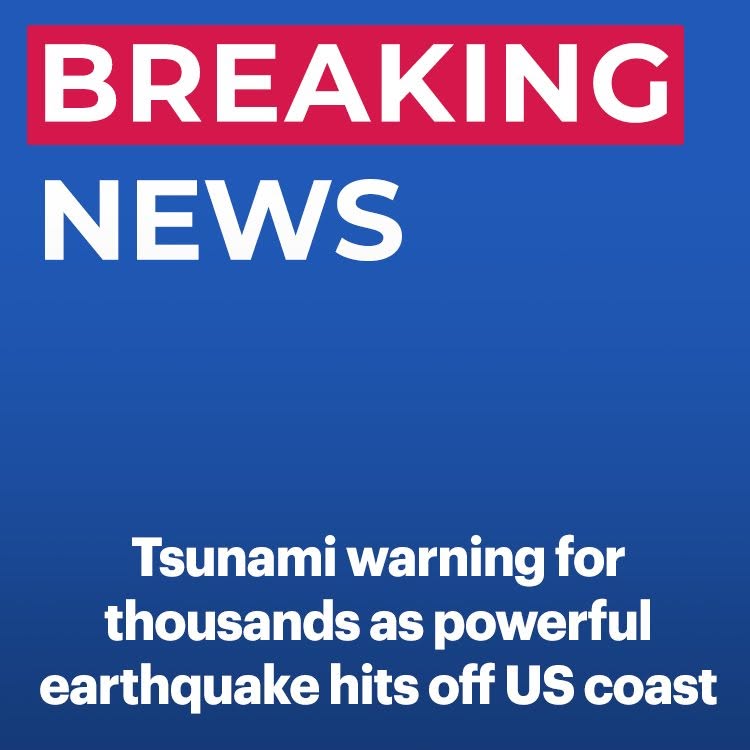Thousand of Americans along Alaska’s coastline raced to higher ground on Wednesday, abandoning their homes after a major earthquake triggered a tsunami warning.
The US Geological Survey (USGS) detected a 7.3 magnitude at approximately 12:38pm local time (4:30pm ET), centered in the Pacific Ocean just south of the Alaska Peninsula near the Shumagin Islands, southeast of Sand Point.
Sirens wailed and emergency alerts lit up phones across the region, warning residents across a vast stretch of southwestern Alaska, from Kennedy Entrance near Homer to Unimak Pass near Unalaska, to evacuate immediately.
Officials warned of potential tsunami impacts on Kodiak Island, the Alaska Peninsula, and parts of the eastern Aleutian Islands, with some areas expected to be hit first.
Dramatic images showed an eerily bare shoreline, the ocean having suddenly vanished, a chilling sign that a tsunami could be moments away.
Rachel Lord. the mayor of Spit, said: ‘We’ve been hearing [that] initially there was a lot of like bumper-to-bumper traffic and people just trying to get you know get off the spit.’
David Snider, a tsunami warning coordinator at the National Oceanic and Atmospheric Administration, told KTUU that a tsunami had been confirmed.
A six-inch wave was later reported and confirmed by the US Coast Guard, though officials have not disclosed the exact location where the wave was detected.

The tsunami could hit coastal areas of southwestern Alaska, including communities from Kennedy Entrance near Homer to Unimak Pass near Unalaska, with potential impact on Kodiak Island, the Alaska Peninsula and parts of the eastern Aleutian Islands

The initial alert issued a full tsunami warning shortly after the 7.3 magnitude quake struck, but the threat was downgraded to a tsunami advisory roughly 90 minutes later and then canceled at 12:45pm local (6:45pm ET).
Locals have been warned that unusual waves continuing for about 24 hours, and top stay cautious on Thursday.
The Alaska Earthquake Center has recorded more than 20 aftershocks following Wednesday’s powerful quake, with the strongest so far measuring magnitude 5.2.
As panic spread across coastal communities, officials confirmed that Kodiak High School and North Star Elementary School had been opened to the public as emergency shelters.
The National Weather Service (NWS) issued a statement confirming there was no tsunami threat to Oregon, Washington or other US states outside Alaska.
However, the agency is urged Alaskans to move out of the water, off the beach and away from harbors, marinas, breakwaters, bays and inlets as a precaution.
In Seward, a southern Alaska port town, one resident shared a video to X, revealing she had just returned to Alaska after 25 years, only to find herself fleeing from a tsunami threat.
The clip shows her and several others walking briskly away from the coast and heading for higher ground.

In Seward, a southern Alaska port town, one resident revealed she had just returned to Alaska after 25 years, only to find herself fleeing from a tsunami threat. The clip shows her and several others walking briskly away from the coast and heading for higher ground
‘Just pray we don’t get waved,’ she says nervously, before ending the recording.
The NTWC said the advisory covered an area stretching approximately 700 miles, from about 40 miles southwest of Homer to Unimak Pass, near the eastern Aleutian Islands.

The US Tsunami Center said the warning was in effect from about 40 miles southwest of Homer (pictured) to Unimak Pass, a distance of about 700 miles.

A major 7.3 magnitude earthquake off the coast of Alaska , triggering a tsunami alert for thousands of residents. Pictured is Sand Point, which is under the alert
Kodiak, with a population of around 5,200, is one of the largest communities within the advisory zone.
In King Cove, a coastal town of about 870 residents on the south side of the Alaska Peninsula, local officials issued an alert urging people in low-lying areas to move to higher ground.
The last time Alaska experienced an earthquake of similar magnitude was on June 10, 1996, when a magnitude 7.2 quake struck near the Andreanof Islands in the Aleutian chain.
The most powerful earthquake ever recorded in Alaska, and in US history, was the 1964 Great Alaska Earthquake, which registered a magnitude of 9.2.
That massive quake struck near Prince William Sound and was felt as far away as Seattle.
It also generated devastating tsunamis that caused widespread damage along coastlines in Alaska, Oregon, California, Hawaii, and even as far as Japan.







13 Comments